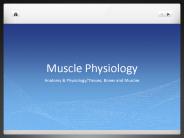Unit V: Movement Muscle Contraction - Part I - PowerPoint PPT Presentation
1 / 15
Title:
Unit V: Movement Muscle Contraction - Part I
Description:
Unit V: Movement Muscle Contraction - Part I Chapter 9 pg 286-291 Electrophysiology of Muscle Tissue Review Resting, excitable cell polarized Resting muscle ... – PowerPoint PPT presentation
Number of Views:30
Avg rating:3.0/5.0
Title: Unit V: Movement Muscle Contraction - Part I
1
Unit V MovementMuscle Contraction - Part I
- Chapter 9 pg 286-291
2
Electrophysiology of Muscle Tissue
- Review
- Resting, excitable cell polarized
- Resting muscle cell excess Na outside, K and
anions inside - Resting Membrane Potential
- Stimulation of muscle cell Na enters, then K
leaves - Action Potential
- spreads along the sarcolemma
3
Excitation of a Muscle FiberSteps 1 2
1. Nerve signal opens voltage-gated calcium
channels. 2. Calcium stimulates exocytosis
of synaptic vesicles containing ACh ACh release
into synaptic cleft.
4
Excitation of a Muscle FiberSteps 3 4
3. Binding of ACh to receptor proteins 4. opens
Na and K channels resulting in reversed
polarity forming an end-plate potential (EPP).
5
Excitation of a Muscle FiberSteps 5
5. Voltage change in end-plate region (EPP) opens
nearby voltage-gated ion channels producing an
action potential
6
Excitation-Contraction CouplingSteps 6 7
6. Action potential spreading over sarcolemma
enters T tubules 7. voltage-gated channels open
in T tubules causing calcium gates to open in SR
7
Excitation-Contraction CouplingSteps 8 9
Resting Sarcomere
8. Calcium released by SR binds to troponin. 9.
Troponin-tropomyosin complex changes shape and
exposes active sites on actin.
8
ContractionSteps 10 11
10. Myosin ATPase in myosin head hydrolyzes an
ATP molecule, activating the head and cocking
it in an extended position. 11. It binds to
actin active site forming a cross-bridge.
9
ContractionSteps 12 13
- Power stroke myosin head releasesADP and
phosphate as it flexes pulling the thin
filament past the thick - Recovery stroke
- with the binding of more ATP, the myosin head
extends to attach to a new active site
Contracted Sarcomere
10
ContractionSliding Filament Theory
- Thick and thin filaments slide past one another
- They DO NOT become shorter!
- Half of myosin heads bound to thin filaments at a
time
http//www.youtube.com/watch?vWRxsOMenNQM
11
RelaxationSteps 14 15
14. Nerve stimulation ceases 15.
Acetylcholinesterase removes ACh from receptors.
Stimulation of the muscle cell ceases.
12
RelaxationSteps 16
16. Active transport needed to pump calcium back
into SR to bind to calsequestrin.
13
RelaxationSteps 17 18
17. Loss of calcium from troponin. 18.
Moves troponin-tropomyosin complex over active
sites. Muscle fiber returns to its resting length.
14
Rigor Mortis
- Hardening of muscles, stiffening of body
- Time period 3 60 hours after death
- No ATP being produced!
15
Myasthenia Gravis
- Women between ages 20-40
- Autoimmune disease
- Antibodies clump ACh receptors together
- Muscle fibers less sensitive to ACh
- Treatment
- Cholinesterase inhibitors
- Immunosuppresive agents
- Removal of thymus































